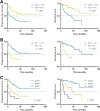Serum D-dimer, albumin and systemic inflammatory response markers in ovarian clear cell carcinoma and their prognostic implications
- PMID: 32771026
- PMCID: PMC7415177
- DOI: 10.1186/s13048-020-00693-w
Serum D-dimer, albumin and systemic inflammatory response markers in ovarian clear cell carcinoma and their prognostic implications
Abstract
Background: This study attempts to evaluate whether preoperative systemic inflammatory response (SIR) markers or other hematological variables, such as albumin, D-dimer, and carbohydrate antigen 125, play roles in predicting chemotherapy response and survival outcome in patients with ovarian clear cell carcinoma (OCCC).
Methods: Preoperative leukocyte differential counts, as well as platelet, serum albumin, plasma D-dimer and CA-125 levels, were measured in patients with FIGO IC-IV ovarian clear cell cancer. The correlations of these hematological biomarkers with clinicopathological features, chemotherapy response, and survival outcomes were further analyzed. Survival time was estimated using the Kaplan-Meier model, whereas Cox regression was conducted for multivariate analysis.
Results: Among the 84 patients, 28.6% were classified as platinum resistant, and 69.0% were platinum sensitive. Preoperative CA125, albumin, and D-dimer levels; neutrophil to lymphocyte ratios (NLR); and monocyte to lymphocyte ratios were significantly correlated with FIGO stage, residual tumor, and platinum response. Platelet to lymphocyte ratio was not related to platinum response (P = 0.060). The median follow-up time was 28 months (range, 1 to 128 months). Preoperative CA125, albumin, and D-dimer levels were significant prognostic factors for overall survival (OS) and progression-free survival (PFS). In the univariate analysis, only NLR exhibited prognostic significance for PFS (P = 0.007). Multivariate analysis indicated that D-dimer > 3.27 (P = 0.001 for OS; P = 0.040 for PFS) and albumin < 39.6 (P = 0.005 for OS and P = 0.041 for PFS) retained significance.
Conclusions: Preoperative NLR has some predictive value for platinum resistance in patients with IC-IV stage OCCC but has little predictive effect on prognosis. Elevated D-dimer and reduced albumin might be potential biomarkers for worse response to first-line platinum-based chemotherapy and poor clinical outcomes.
Keywords: Albumin; Clear cell carcinoma; D-dimer; Neutrophil to lymphocyte ratio; Ovarian neoplasms; Platinum resistance; Recurrence; Survival.
Conflict of interest statement
The authors declare that they have no competing interests.
Figures



Similar articles
-
Fibrinogen/albumin ratio as a promising predictor of platinum response and survival in ovarian clear cell carcinoma.BMC Cancer. 2022 Jan 21;22(1):92. doi: 10.1186/s12885-022-09204-0. BMC Cancer. 2022. PMID: 35062908 Free PMC article.
-
Elevated preoperative plasma D-dimer level is a useful predictor of chemoresistance and poor disease outcome for serous ovarian cancer patients.Cancer Chemother Pharmacol. 2015 Dec;76(6):1163-71. doi: 10.1007/s00280-015-2900-y. Epub 2015 Nov 5. Cancer Chemother Pharmacol. 2015. PMID: 26542279
-
Neutrophil to lymphocyte ratio and platelet to lymphocyte ratio are predictive of chemotherapeutic response and prognosis in epithelial ovarian cancer patients treated with platinum-based chemotherapy.Cancer Biomark. 2016 Jun 7;17(1):33-40. doi: 10.3233/CBM-160614. Cancer Biomark. 2016. PMID: 27314290
-
Prognostic value of systemic inflammatory markers in ovarian Cancer: a PRISMA-compliant meta-analysis and systematic review.BMC Cancer. 2018 Apr 18;18(1):443. doi: 10.1186/s12885-018-4318-5. BMC Cancer. 2018. PMID: 29669528 Free PMC article. Review.
-
CA-125 change after chemotherapy in prediction of treatment outcome among advanced mucinous and clear cell epithelial ovarian cancers: a Gynecologic Oncology Group study.Cancer. 2009 Apr 1;115(7):1395-403. doi: 10.1002/cncr.24152. Cancer. 2009. PMID: 19195045 Free PMC article. Review.
Cited by
-
Independent predictive value of blood inflammatory composite markers in ovarian cancer: recent clinical evidence and perspective focusing on NLR and PLR.J Ovarian Res. 2023 Feb 9;16(1):36. doi: 10.1186/s13048-023-01116-2. J Ovarian Res. 2023. PMID: 36759864 Free PMC article. Review.
-
Development and Validation of a Nomogram to Predict the Risk of Special Uterine Leiomyoma Pathological Types or Leiomyosarcoma in Postmenopausal Women: A Retrospective Study.Risk Manag Healthc Policy. 2024 Jun 21;17:1669-1685. doi: 10.2147/RMHP.S461773. eCollection 2024. Risk Manag Healthc Policy. 2024. PMID: 38919406 Free PMC article.
-
Nutritional assessment of Chinese gynecologic cancer survivors with post-surgical lower limb lymphedema: a cross-sectional study.Front Nutr. 2024 Oct 28;11:1484017. doi: 10.3389/fnut.2024.1484017. eCollection 2024. Front Nutr. 2024. PMID: 39529928 Free PMC article.
-
Predictive value of indicator of CA125 combined with D-dimer (ICD) for lymph node metastasis in patients with ovarian cancer: A two center cohort study.J Cancer. 2022 May 1;13(8):2447-2456. doi: 10.7150/jca.70737. eCollection 2022. J Cancer. 2022. PMID: 35711840 Free PMC article.
-
Fibrinogen/albumin ratio as a promising predictor of platinum response and survival in ovarian clear cell carcinoma.BMC Cancer. 2022 Jan 21;22(1):92. doi: 10.1186/s12885-022-09204-0. BMC Cancer. 2022. PMID: 35062908 Free PMC article.
References
MeSH terms
Substances
Grants and funding
LinkOut - more resources
Full Text Sources
Medical
Research Materials
Miscellaneous

